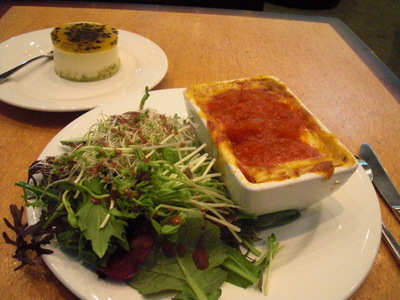
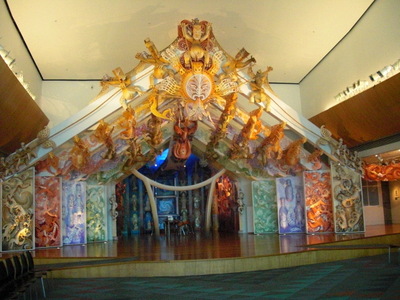 Thursday, the rain continued, so I once again spent the day at Te Papa, working on blog notes and the internet in the morning and then, after lunch at the museum's upscale "Espresso" café, more exploration of the museum collections.
Thursday, the rain continued, so I once again spent the day at Te Papa, working on blog notes and the internet in the morning and then, after lunch at the museum's upscale "Espresso" café, more exploration of the museum collections.Thursday, 6 December 2012: Wellington, Te Papa again

 Thursday, the rain continued, so I once again spent the day at Te Papa, working on blog notes and the internet in the morning and then, after lunch at the museum's upscale "Espresso" café, more exploration of the museum collections.
Thursday, the rain continued, so I once again spent the day at Te Papa, working on blog notes and the internet in the morning and then, after lunch at the museum's upscale "Espresso" café, more exploration of the museum collections.
Lunch was a quite a good individual vegetarian lasagne, served at the temperature of molten lava, with a balsamic-vinaigrette-dressed salad on the side and passionfruit/yogurt-bavarian/pistachio-cake pastry for dessert.
No museum in New Zealand is complete without an example of an elaborately and ornately carved Maori meeting house, and Te Papa is no exception. I had already visited the one a couple of floors down. On the top floor of the museum, though, I found this one, which is entirely modern and is not a museum specimen. It is the fully functional national Maori meeting house.

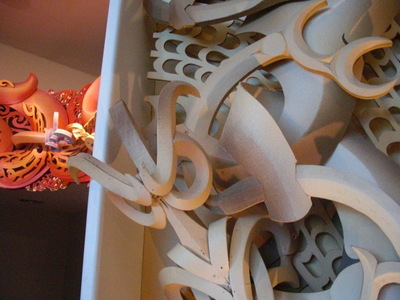 These two photos show details of the modern take on the traditional ornate carvings. In the back of what would be called the "apse" in a church are dozens of panels (the narrow vertical bands one can see behind the "pi"-shaped arch) depicting every imaginable occupation and profession. Also behind the arch were a small table and a couple of chairs, at which were provided registration cards, on which visitors could enter their names and addresses and indicate which of the panels most closely reflected their careers. I wasn't sure whether the cards were only for Maoris, or only for New Zealanders, so I didn't fill one out.
These two photos show details of the modern take on the traditional ornate carvings. In the back of what would be called the "apse" in a church are dozens of panels (the narrow vertical bands one can see behind the "pi"-shaped arch) depicting every imaginable occupation and profession. Also behind the arch were a small table and a couple of chairs, at which were provided registration cards, on which visitors could enter their names and addresses and indicate which of the panels most closely reflected their careers. I wasn't sure whether the cards were only for Maoris, or only for New Zealanders, so I didn't fill one out.
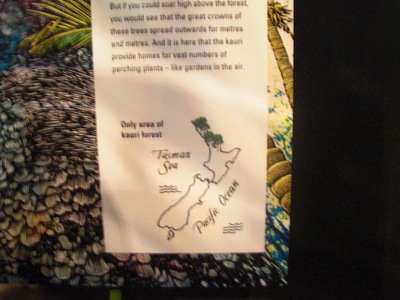
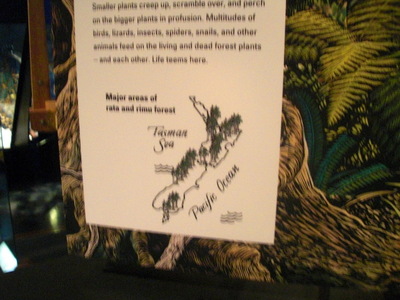 Downstairs in the natural-history section, I found an explanation of the three main New Zealand forest types, maps for two of which are shown here and that for the third below. The images aren't in very good focus, but they serve to show the major vegetation zones with respect to the overall outline of the two islands.
Downstairs in the natural-history section, I found an explanation of the three main New Zealand forest types, maps for two of which are shown here and that for the third below. The images aren't in very good focus, but they serve to show the major vegetation zones with respect to the overall outline of the two islands.
At the left is the kauri forest zone, at the northern endof the North Island. Auckland is located near its southern limit. At the right is the rata-rimu forest (rata, Metrosideros spp., Myrtaceae, and rimu, Dacrydium cupressinum, Podocarpaceae, are two common trees characterizing that forest type).
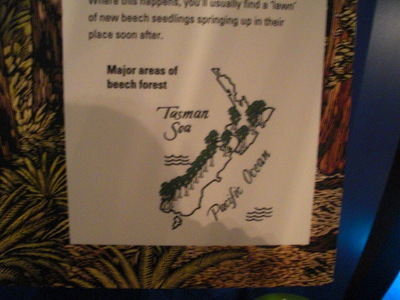
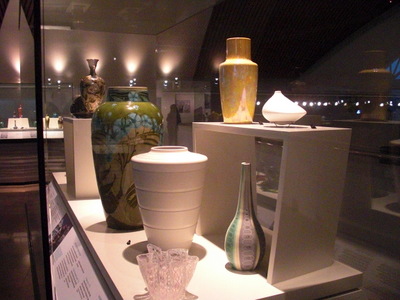 The third type (right-hand photo) is the southern beech (Nothofagus spp., Nothofagaceae) forest. Wellington, and therefore Zealandia, is in the rata-rimu zone, although areas of southern beech are not far away. That explained, rather to my relief, why I saw no kauri's there. I was worried that the Wellington area had lost all its kauris to the dieback disease. New Zealand is losing its rata trees to, of all things, the brushtail possum (Trichosurus vulpecula), a rapidly spreading invasive exotic from Australia.
The third type (right-hand photo) is the southern beech (Nothofagus spp., Nothofagaceae) forest. Wellington, and therefore Zealandia, is in the rata-rimu zone, although areas of southern beech are not far away. That explained, rather to my relief, why I saw no kauri's there. I was worried that the Wellington area had lost all its kauris to the dieback disease. New Zealand is losing its rata trees to, of all things, the brushtail possum (Trichosurus vulpecula), a rapidly spreading invasive exotic from Australia.
Finally, up near the top of the museum, I found the Walter Cook collection. Cook is a private collector who has spent most of his life in Wellington and has an uncommonly good eye for glass and ceramics—he picked up much of his collection in local New Zealand junk shops and gave the collection to the museum in the 1990's. He still works as a librarian in Wellington.
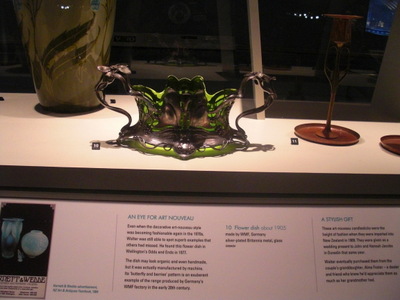
 I love art glass, so I spent quite a while studying the pieces, trying to get photos without too many flares and distracting reflections in them.
I love art glass, so I spent quite a while studying the pieces, trying to get photos without too many flares and distracting reflections in them.
You can see images of many, many more on the Te Papa website. The photographer who made those was allowed to set them against a plain background and light them to advantage.
I have, of course, left out dozens of exhibits (e.g., a special showing of paintings from the colonial era, relics of Pharlap, lots more natural history, New Zealand's role in foreign wars). I spent, in all more than a full day there, and that wasn't enough to give even a cursory glance to all that was on offer. A wonderful museum—I recommend it highly.
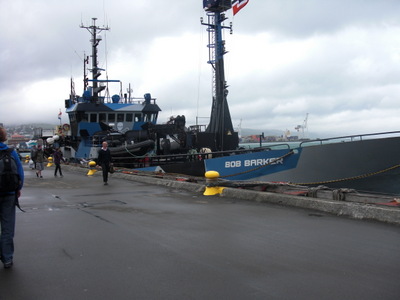
 After the final session of the day, a special reception and art exhibition had been laid on for us at the City Gallery on Civic Square, a short walk away, either by city streets or along the waterfront. We chose the latter, and on the way passed Bob Barker's Sea Shepherd, an ecopirate vessel that harrasses whaling ships. Its emblem is a skull and crossbones, but the crossbones are replaced by a trident crossed with a shepherd's crook. The crew were offering free boat tours, but we didn't take the time. I'm pretty sure it's not the same Bob Barker who hosted Truth or Consequences and "The Price is Right.
After the final session of the day, a special reception and art exhibition had been laid on for us at the City Gallery on Civic Square, a short walk away, either by city streets or along the waterfront. We chose the latter, and on the way passed Bob Barker's Sea Shepherd, an ecopirate vessel that harrasses whaling ships. Its emblem is a skull and crossbones, but the crossbones are replaced by a trident crossed with a shepherd's crook. The crew were offering free boat tours, but we didn't take the time. I'm pretty sure it's not the same Bob Barker who hosted Truth or Consequences and "The Price is Right.
Civic square is marked by this wonderful metal "fern ball," suspended high overhead in the center of the open space. I hadn't noticed it before because I approached the I-site from the inland side and never actually ventured into the square itself.
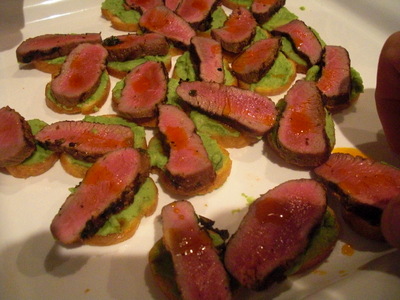
 The are show was great, but photography was strictly forbidden, as was taking food and drink out of the lobby and into the galleries, so my photography was restricted to shots of the passed hors d'oeuvres taken in the lobby. We were offered several kinds, all delicious, but these were the most photogenic.
The are show was great, but photography was strictly forbidden, as was taking food and drink out of the lobby and into the galleries, so my photography was restricted to shots of the passed hors d'oeuvres taken in the lobby. We were offered several kinds, all delicious, but these were the most photogenic.
On the left, grilled spiced lamb on on toasts spread with a fava-bean purée. On the right, little warm fritters of some kind topped with diced avocado. I didn't actually taste those, being allergic to avocado.
The theme of the of exhibition was the area of the Kermadec Islands, north of New Zealand, which is a candidate for protected status. The gallery chartered a boat and invited a group of artists to cruise from New Zealand to Tonga, through the Kermadec, gathering ideas and material for art works, emphasizing their ecological importance. They all jumped at the chance, even several to who had to clear busy international travel schedules.
Each artist in turn gave a short talk about his or her works, some of which were fascinating and others incomprehensible, just like the pieces themselves (although the fascinating talks were not necessarily about the fascinating works or vice versa). One, a photographer, captivated the crowd by talking about his photo of a left rubber thong sandal (called a "jandal" in New Zealand) washed up as flotsam on the beach at Tonga. He maintained that he had found a number of such sandals, and that they were all left-footed. He had since done experiments, in Wellington harbor and elsewhere, releasing sandals in equal numbers, but in all cases, 8 out of 10 recovered were left-footed. The scientists were quick to offer explanations, ranging from frivolous to mystical to deadly serious, and that talk went on for much longer than its allotted 15 minutes. David and I both recalled a paper published years ago about the distribution of left red rubber sandals recovered in the North Pacific gyre. David made a note to send the artist a copy, but I don't know whether he's gotten around to it.
It had gotten pretty late by the time we went in search of dinner. David was feeling under the weather, complaining of sore teeth and a possible sinus infection (he'd already sent me out earlier in the week to get some sensitive-teeth toothpaste, as they'd been bothering him off and on), but Buz Wilson and I talked him out of just skipping dinner and going straight to bed, and we found a great light dinner off the starters menu at a restaurant on Courtenay Place called Hummingbird.
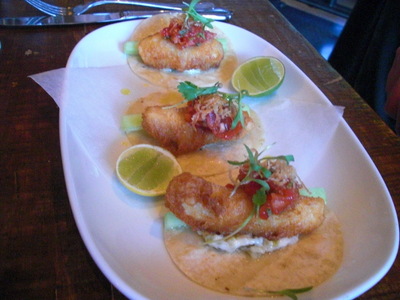
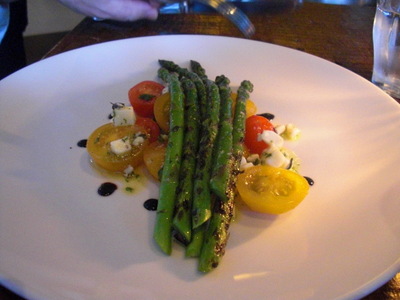 Buz ordered fish tacos, made with "groper" (which I think is the same things as "hapuka"; definitely not the same as "grouper") with crushed peas, mint, and coriander. They were great. I traded him one of my lobster sliders for one of his tacos.
Buz ordered fish tacos, made with "groper" (which I think is the same things as "hapuka"; definitely not the same as "grouper") with crushed peas, mint, and coriander. They were great. I traded him one of my lobster sliders for one of his tacos.

 Here are my lobster sliders, with lemon, watercress, and "QP mayo," which I think is a brand of Japanese-style mayonnaise. They were yummy.
Here are my lobster sliders, with lemon, watercress, and "QP mayo," which I think is a brand of Japanese-style mayonnaise. They were yummy.
At the right is what you get when you order a "flat white" coffee—a sort of coffee-with-cream/capucino sort of thing. It was our standard coffee order once we learned the name.
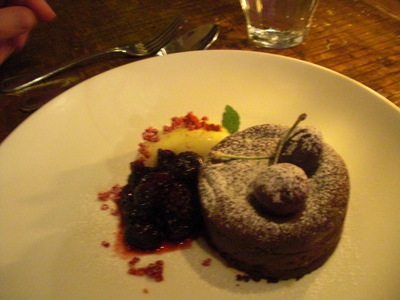
 For dessert, David ordered molten chocolate cakes with "old boy" (i.e., brandy-soaked) fruit preserves.
For dessert, David ordered molten chocolate cakes with "old boy" (i.e., brandy-soaked) fruit preserves.
Buz and I both had the "mango parfait," with coconut, meringue, and coriander. Outstanding!